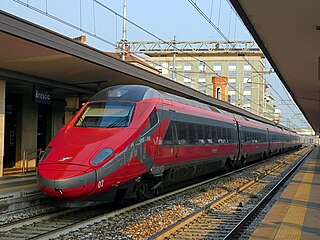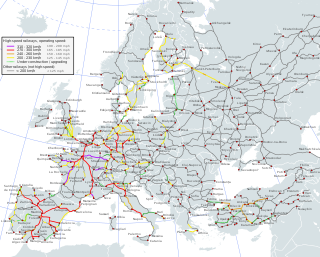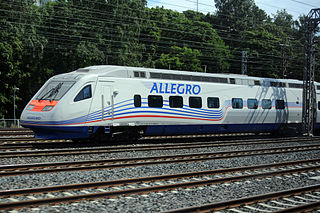
VR-Group Plc, commonly known as VR, is a government-owned railway company in Finland. VR's most important function is the operation of Finland's passenger rail services with 250 long-distance and 800 commuter rail services every day. With 7,500 employees and net sales of €1,251 million in 2017, VR is one of the most significant operators in the Finnish public transport market area.

Pendolino is an Italian family of high-speed tilting trains used in Italy, Spain, Germany, Poland, Portugal, Slovenia, Finland, the Czech Republic, Slovakia, the UK, the US, Switzerland, China, and Greece. It was also used in Russia from December 12, 2010 until March 26, 2022. Based on the design of the Italian ETR 401, it was further developed and manufactured by Fiat Ferroviaria, which was taken over by Alstom in 2000.

InterCity is the classification applied to certain long-distance passenger train services in Europe. Such trains generally call at major stations only.

The British Rail Class 390 Pendolino is a type of electric high-speed passenger train operated by Avanti West Coast in the United Kingdom, leased from Angel Trains. They are electric multiple units using Fiat Ferroviaria's tilting train Pendolino technology and built by Alstom. Fifty-three units were originally built between 2001 and 2004 for operation on the West Coast Main Line (WCML). They were ordered as eight-car units, later extended to nine cars, of which some were then lengthened further to 11 cars. These new 11-car trains were renumbered as the subclass 390/1. The trains of the original batch were the last to be assembled at Alstom's Washwood Heath plant, before its closure in 2005. The remaining trains in the fleet were built in Italy.

The Finnish railway network consists of a total track length of 9,216 km (5,727 mi). The railways are built with a broad 1,524 mm track gauge, of which 3,249 km (2,019 mi) is electrified. Passenger trains are operated by the state-owned enterprise VR that runs services on 7,225 km (4,489 mi) of track. These services cover all major cities and many rural areas, though the coverage is less than the coverage provided by the bus services. Most passenger train services originate or terminate at Helsinki Central railway station, and a large proportion of the passenger rail network radiates out of Helsinki. VR also operates freight services. Maintenance and construction of the railway network itself is the responsibility of the Finnish Rail Administration, which is a part of the Finnish Transport Agency. The network consists of six areal centres, that manage the use and maintenance of the routes in co-operation. Cargo yards and large stations may have their own signalling systems.

Pasila station is a railway station in Helsinki, Finland, approximately 3.5 kilometres (2.2 mi) north of Helsinki Central. It is the second busiest railway station in Finland, after Helsinki Central, and takes up a large part of the district of Pasila. The station was first opened in 1862 along the Finnish Main Line. The current station building opened in 2019.

The New Pendolino is a class of high-speed tilting trains built by Alstom Ferroviaria for Trenitalia and Cisalpino.

Railways with a railway track gauge of 5 ft first appeared in the United Kingdom and the United States. This gauge became commonly known as "Russian gauge", because the government of the Russian Empire chose it in 1843. Former areas and states of the Empire have inherited this standard. However in 1970, Soviet Railways re-defined the gauge as 1,520 mm.

The Kouvola railway station is located in the city of Kouvola in Finland.

The Sm3 Pendolino is a class of high-speed body-tilting trains operated by VR Group. It is a member of the Pendolino train family; its design is based on the ETR 460. The first two trainsets were assembled in Finland by Rautaruukki-Transtech in the mid-1990s. The rest of the series of eighteen EMUs were built by Fiat Ferroviaria between 2000 and 2006. The trains serve most of Finland's major cities such as Helsinki, Turku, Oulu and Joensuu with a maximum speed of 220 km/h (140 mph), although this speed is only attained between Kerava and Lahti. The train has a power output of 4,000 kW (5,400 hp) and weighs 328 tonnes.

Although Finland has no dedicated high-speed rail lines, sections of its rail network are capable of running speeds of 200 km/h (124 mph). The Finnish national railway company VR operates tilting Alstom Pendolino trains. The trains reach their maximum speed of 220 km/h (137 mph) in regular operation on a 75.7 km (47.0 mi) route between Kerava and Lahti. This portion of track was opened in 2006. The trains can run at 200 km/h (124 mph) on a longer route between Helsinki and Seinäjoki and peak at that speed between Helsinki and Turku. The main railway line between Helsinki and Oulu has been upgraded between Seinäjoki and Oulu to allow for trains to run at speeds between 160 km/h (99 mph) and 200 km/h (124 mph). Other parts of the Finnish railway network are limited to lower speed.

The Riihimäki–Saint Petersburg railway is a 385-kilometre (239 mi) long segment of the Helsinki–Saint Petersburg connection, which is divided between Saint Petersburg and Leningrad Oblast in Russia and the province of Southern Finland in Finland.

The Polish railways network consists of around 18,510 kilometres (11,500 mi) of track as of 2019, of which 11,998 km (7,455 mi) is electrified. The national electrification system runs at 3 kV DC.

High-speed rail (HSR) has developed in Europe as an increasingly popular and efficient means of transport. The first high-speed rail lines on the continent, built in the 1970s, 1980s, and 1990s, improved travel times on intra-national corridors. Since then, several countries have built extensive high-speed networks, and there are now several cross-border high-speed rail links. Railway operators frequently run international services, and tracks are continuously being built and upgraded to international standards on the emerging European high-speed rail network.

Nuovo Trasporto Viaggiatori S.p.A. is an Italian open-access train operating company operating in the field of high-speed rail transport under the brand name Italo, stylized as .italo.

Vainikkala is a small village of approximately 400 inhabitants in South Karelia, Eastern Finland. It is part of the Lappeenranta municipality and is located about 29 kilometres (18 mi) south of the city centre.
High-speed rail service (Polish: Kolej dużych prędkości) commenced in Poland on 14 December 2014, with the introduction of 20 non-tilting New Pendolino trainsets operating on 4 designated lines radiating out from Warsaw. Polish State Railways started passenger service using Pendolino trains operating at a maximum speed of 200 km/h on 80 km line Olszamowice-Zawiercie (part of railway line called CMK, from Warsaw to Katowice/Kraków). From December 2017 there are two 200 km/h sections, 136 km long in total. All high-speed services operated by PKP in Poland are branded as Express Intercity Premium (EIP).

High-speed rail is emerging in Russia as an increasingly popular means of transport, where it is twice as fast as the regular express trains between Moscow and Saint Petersburg.

Allegro was the brand name of a now defunct high-speed train service, operated by Alstom VR Class Sm6 trains, between Helsinki, Finland, and St. Petersburg, Russia.

The Sibelius was a train run daily by VR between Helsinki, Finland, and St. Petersburg, Russia. The service began on 31 May 1992 in order to ease congestion on the night service train Repin and due to the fall of the Soviet Union, where traffic was increased on the border.


















